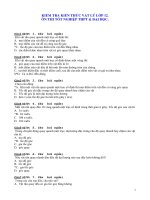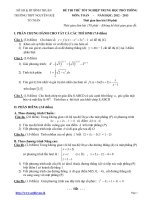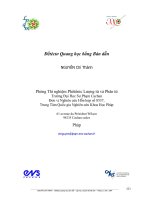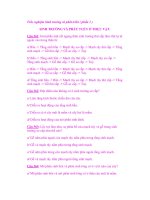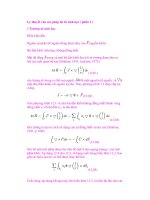PSIM User Manual phần 1 pdf
Bạn đang xem bản rút gọn của tài liệu. Xem và tải ngay bản đầy đủ của tài liệu tại đây (99.38 KB, 16 trang )
PSIM
User Manual
Powersim Inc.
PSIM User Manual
PSIM Version 6.0
April 2003
Copyright 2001-2003 Powersim Inc.
All rights reserved. No part of this manual may be photocopied or reproduced in any form or by any means without
the written permission of Powersim Inc.
Disclaimer
Powersim Inc. (“Powersim”) makes no representation or warranty with respect to the adequacy or accuracy of this
documentation or the software which it describes. In no event will Powersim or its direct or indirect suppliers be lia-
ble for any damages whatsoever including, but not limited to, direct, indirect, incidental, or consequential damages of
any character including, without limitation, loss of business profits, data, business information, or any and all other
commercial damages or losses, or for any damages in excess of the list price for the licence to the software and docu-
mentation.
Powersim Inc.
email:
PSIM User Manual
iii
Table of Contents
Chapter 1 General Information
1.1 Introduction 1-1
1.2 Circuit Structure 1-1
1.3 Software/Hardware Requirement 1-2
1.4 Installing the Program 1-2
1.5 Simulating a Circuit 1-3
1.6 Component Parameter Specification and Format 1-3
Chapter 2 Power Circuit Components
2.1 Resistor-Inductor-Capacitor Branches 2-1
2.1.1 Resistors, Inductors, and Capacitors 2-1
2.1.2 Rheostat 2-2
2.1.3 Saturable Inductor 2-2
2.1.4 Nonlinear Elements 2-3
2.2 Switches 2-5
2.2.1 Diode, DIAC, and Zener Diode 2-5
2.2.2 Thyristor and TRIAC 2-7
2.2.3 GTO, Transistors, and Bi-Directional Switch 2-8
2.2.4 Linear Switches 2-10
2.2.5 Switch Gating Block 2-11
2.2.6 Single-Phase Switch Modules 2-13
2.2.7 Three-Phase Switch Modules 2-14
2.3 Coupled Inductors 2-16
2.4 Transformers 2-17
2.4.1 Ideal Transformer 2-17
2.4.2 Single-Phase Transformers 2-18
2.4.3 Three-Phase Transformers 2-20
2.5 Other Elements 2-22
2.5.1 Operational Amplifier 2-22
iv
PSIM User Manual
2.5.2 dv/dt Block 2-23
2.6 Motor Drive Module 2-24
2.6.1 Electric Machines 2-24
2.6.1.1 DC Machine 2-24
2.6.1.2 Induction Machine 2-27
2.6.1.3 Induction Machine with Saturation 2-31
2.6.1.4 Brushless DC Machine 2-33
2.6.1.5 Synchronous Machine with External Excitation 2-38
2.6.1.6 Permanent Magnet Synchronous Machine 2-40
2.6.1.7 Switched Reluctance Machine 2-43
2.6.2 Mechanical Loads 2-45
2.6.2.1 Constant-Torque Load 2-45
2.6.2.2 Constant-Power Load 2-46
2.6.2.3 Constant-Speed Load 2-47
2.6.2.4 General-Type Load 2-48
2.6.3 Gear Box 2-48
2.6.4 Mechanical-Electrical Interface Block 2-49
2.6.5 Speed/Torque Sensors 2-51
Chapter 3 Control Circuit Components
3.1 Transfer Function Blocks 3-1
3.1.1 Proportional Controller 3-2
3.1.2 Integrator 3-2
3.1.3 Differentiator 3-3
3.1.4 Proportional-Integral Controller 3-4
3.1.5 Built-in Filter Blocks 3-5
3.2 Computational Function Blocks 3-6
3.2.1 Summer 3-6
3.2.2 Multiplier and Divider 3-7
3.2.3 Square-Root Block 3-7
3.2.4 Exponential/Power/Logarithmic Function Blocks 3-7
3.2.5 Root-Mean-Square Block 3-8
3.2.6 Absolute and Sign Function Blocks 3-9
3.2.7 Trigonometric Functions 3-9
3.2.8 Fast Fourier Transform Block 3-9
PSIM User Manual
v
3.3 Other Function Blocks 3-10
3.3.1 Comparator 3-10
3.3.2 Limiter 3-11
3.3.3 Gradient (dv/dt) Limiter 3-11
3.3.4 Look-up Table 3-12
3.3.5 Trapezoidal and Square Blocks 3-13
3.3.6 Sampling/Hold Block 3-14
3.3.7 Round-Off Block 3-15
3.3.8 Time Delay Block 3-16
3.3.9 Multiplexer 3-17
3.3.10 THD Block 3-18
3.4 Logic Components 3-19
3.4.1 Logic Gates 3-19
3.4.2 Set-Reset Flip-Flop 3-20
3.4.3 J-K Flip-Flop 3-21
3.4.4 D Flip-Flop 3-21
3.4.5 Monostable Multivibrator 3-21
3.4.6 Pulse Width Counter 3-22
3.4.7 A/D and D/A Converters 3-22
3.5 Digital Control Module 3-24
3.5.1 Zero-Order Hold 3-24
3.5.2 z-Domain Transfer Function Block 3-25
3.5.2.1 Integrator 3-26
3.5.2.2 Differentiator 3-27
3.5.2.3 Digital Filters 3-28
3.5.3 Unit Delay 3-31
3.5.4 Quantization Block 3-31
3.5.5 Circular Buffer 3-33
3.5.6 Convolution Block 3-33
3.5.7 Memory Read Block 3-34
3.5.8 Data Array 3-35
3.5.9 Stack 3-35
3.5.10 Multi-Rate Sampling System 3-36
3.6 SimCoupler Module 3-37
3.6.1 Set-up in PSIM and Simulink 3-37
vi
PSIM User Manual
3.6.2 Solver Type and Time Step Selection in Simulink 3-40
Chapter 4 Other Components
4.1 Parameter File 4-1
4.2 Sources 4-1
4.2.1 Time 4-2
4.2.2 DC Sources 4-2
4.2.3 Sinusoidal Sources 4-2
4.2.4 Square-Wave Sources 4-4
4.2.5 Triangular Sources 4-4
4.2.6 Step Sources 4-5
4.2.7 Piecewise Linear Sources 4-6
4.2.8 Random Sources 4-7
4.2.9 Math Function Source 4-8
4.2.10 Voltage/Current-Controlled Sources 4-9
4.2.11 Nonlinear Voltage-Controlled Sources 4-10
4.3 Voltage/Current Sensors 4-12
4.4 Probes and Meters 4-12
4.5 Switch Controllers 4-14
4.5.1 On-Off Switch Controller 4-15
4.5.2 Alpha Controller 4-15
4.5.3 PWM Lookup Table Controller 4-16
4.6 Function Blocks 4-18
4.6.1 Control-Power Interface Block 4-19
4.6.2 ABC-DQO Transformation Block 4-20
4.6.3 Math Function Blocks 4-21
4.6.4 External DLL Blocks 4-22
Chapter 5 Analysis Specification
5.1 Transient Analysis 5-1
5.2 AC Analysis 5-2
5.3 Parameter Sweep 5-6
PSIM User Manual
vii
Chapter 6 Circuit Schematic Design
6.1 Creating a Circuit 6-1
6.2 Editing a Circuit 6-2
6.3 Subcircuit 6-3
6.3.1 Creating Subcircuit - In the Main Circuit 6-4
6.3.2 Creating Subcircuit - Inside the Subcircuit 6-4
6.3.3 Connecting Subcircuit - In the Main Circuit 6-6
6.3.4 Other Features of the Subcircuit 6-6
6.3.4.1 Passing Variables from the Main Circuit to Subcircuit 6-7
6.3.4.2 Customizing the Subcircuit Image 6-8
6.3.4.3 Including Subcircuits in the PSIM Element List 6-9
6.4 Other Options 6-10
6.4.1 Simulation Control 6-10
6.4.2 Running the Simulation 6-10
6.4.3 Generate and View the Netlist File 6-10
6.4.4 Define Runtime Display 6-10
6.4.5 Settings 6-10
6.4.6 Printing the Circuit Schematic 6-11
6.5 Editing PSIM Library 6-11
Chapter 7 Waveform Processing
7.1 File Menu 7-2
7.2 Edit Menu 7-2
7.3 Axis Menu 7-3
7.4 Screen Menu 7-4
7.5 View Menu 7-5
7.6 Option Menu 7-7
7.7 Label Menu 7-8
7.8 Exporting Data 7-8
viii
PSIM User Manual
Chapter 8 Error/Warning Messages and General Simulation Issues
8.1 Simulation Issues 8-9
8.1.1 Time Step Selection 8-9
8.1.2 Propagation Delays in Logic Circuits 8-9
8.1.3 Interface Between Power and Control Circuits 8-9
8.1.4 FFT Analysis 8-10
8.2 Error/Warning Messages 8-10
8.3 Debugging 8-12
Introduction
PSIM User Manual
1-1
Chapter 1: General Information
1.1 Introduction
PSIM is a simulation package specifically designed for power electronics and motor
control. With fast simulation, friendly user interface and waveform processing, PSIM
provides a powerful simulation environment for power converter analysis, control loop
design, and motor drive system studies.
This manual covers both PSIM
*
and its three add-on Modules: Motor Drive Module,
Digital Control Module, and SimCoupler Module. The Motor Drive Module has built-in
machine models and mechanical load models for drive system studies. The Digital Control
Module provides discrete elements such as zero-order hold, z-domain transfer function
blocks, quantization blocks, digital filters, for digital control analysis. The SimCoupler
Module provides interface between PSIM and Matlab/Simulink** for co-simulation.
The PSIM simulation package consists of three programs: circuit schematic program
PSIM, PSIM simulator, and waveform processing program SIMVIEW
*
. The simulation
environment is illustrated as follows.
Chapter 1 of this manual describes the circuit structure, software/hardware requirement,
and installation procedure. Chapter 2 through 4 describe the power and control circuit
components. Chapter 5 describes the specifications of the transient analysis and ac analy-
sis. The use of the PSIM schematic program and SIMVIEW is discussed in Chapter 5 and
6. Finally, error/warning messages are listed in Chapter 7.
1.2 Circuit Structure
A circuit is represented in PSIM in four blocks: power circuit, control circuit, sensors, and
switch controllers. The figure below shows the relationship between these blocks.
*. PSIM and SIMVIEW are copyright by Powersim Inc., 2001-2003
**. Matlab and Simulink are registered trademarks of the MathWorks, Inc.
PSIM Simulator
PSIM Schematic
SIMVIEW
Circuit Schematic Editor (input: *.sch)
PSIM Simulator (input: *.cct; output: *.txt)
Waveform Processor (input: *.txt)
Chapter 1: General Information
1-2
PSIM User Manual
The power circuit consists of switching devices, RLC branches, transformers, and coupled
inductors. The control circuit is represented in block diagram. Components in s domain
and z domain, logic components (such as logic gates and flip flops), and nonlinear compo-
nents (such as multipliers and dividers) can be used in the control circuit. Sensors measure
power circuit voltages and currents and pass the values to the control circuit. Gating sig-
nals are then generated from the control circuit and sent back to the power circuit through
switch controllers to control switches.
1.3 Software/Hardware Requirement
PSIM runs in Microsoft Windows environment 98/NT/2000/XP on PC computers. The
minimum RAM memory requirement is 32 MB.
1.4 Installing the Program
A quick installation guide is provided in the flier “PSIM - Quick Guide” and on the CD-
ROM.
Some of the files in the PSIM directory are:
Files Description
psim.dll PSIM simulator
psim.exe PSIM circuit schematic editor
simview.exe Waveform processor SIMVIEW
psim.lib, psimimage.lib PSIM libraries
*.hlp Help files
*.sch Sample schematic circuit files
Power Circuit
Control Circuit
Sensors
Switch
Controllers
Simulating a Circuit
PSIM User Manual
1-3
File extensions used in PSIM are:
1.5 Simulating a Circuit
To simulate the sample one-quadrant chopper circuit “chop.sch”:
- Start PSIM. Choose
Open
from the
File
menu to load the file “chop.sch”.
- From the
Simulate
menu, choose
Run PSIM
. PSIM simulator will read the
netlist file and start simulation. The simulation results will be saved to File
“chop.txt”. Any warning messages occurred in the simulation will be saved to
File “message.doc”.
- If the option
Auto-run SIMVIEW
is not selected in the
Options
menu, from the
Simulate
menu, choose
Run SIMVIEW
to start SIMVIEW, and select curves
for display. If the option
Auto-run SIMVIEW
is selected, SIMVIEW will be
launched automatically.
1.6 Component Parameter Specification and Format
The parameter dialog window in each component in PSIM has two tabs:
Parameters
and
Other Info,
as shown below.
The parameters in the
Parameters
tab are used to perform the simulation. The informa-
*.sch PSIM schematic file (binary)
*.cct PSIM netlist file (text)
*.txt PSIM simulation output file (text)
*.fra PSIM ac analysis output file (text)
*.smv SIMVIEW waveform file (binary)
Chapter 1: General Information
1-4
PSIM User Manual
tion in the
Other Info
tab, on the other hand, is not used in the simulation. It is for report-
ing purposes and will appear in the parts list in
View
|
Element List
in PSIM. Information
such as device rating, manufacturer, and part no. can be stored under the
Other Info
tab.
The parameters under the
Parameters
tab can be a numerical value, or can be a mathe-
matical expression. A resistance, for example, can be specified in any one of the following
ways:
12.5
12.5k
12.5Ohm
12.5kOhm
25./2.Ohm
R1+R2
R1*0.5+(Vo+0.7)/Io
where R1, R2, Vo, and Io are symbols defined either in a parameter file (see Section 4.3,
Chapter 4 of the PSIM User Manual), or in a main circuit if this resistor is in a subcircuit
(see Section 5.3.4.1, Chapter 5 of the PSIM User Manual).
The power-of-ten suffix letters are allowed in PSIM. The following suffix letters are sup-
ported:
G10
9
M10
6
k or K 10
3
m10
-3
u10
-6
n10
-9
p10
-12
A mathematical expression can contain brackets and is not case sensitive. The following
math functions are allowed:
+ addition
- subtraction
* multiplication
/ division
^ to the power of [Example: 2^3 = 2*2*2]
SQRT square-root function
SIN sine function
COS cosine function
Component Parameter Specification and Format
PSIM User Manual
1-5
TAN tangent function
ATAN inverse tangent function
EXP exponential (base e) [Example: EXP(x) = e
x
]
LOG logarithmic function (base e) [Example: LOG(x) = ln (x)]
LOG10 logarithmic function (base 10)
ABS absolute function
SIGN sign function [Example: SIGN(1.2) = 1; SIGN(-1.2)=-1]
Chapter 1: General Information
1-6
PSIM User Manual
Resistor-Inductor-Capacitor Branches
PSIM User Manual
2-1
Chapter 2: Power Circuit Components
2.1 Resistor-Inductor-Capacitor Branches
2.1.1 Resistors, Inductors, and Capacitors
Both individual resistor, inductor, capacitor branches and lumped RLC branches are pro-
vided in PSIM. Initial conditions of inductor currents and capacitor voltages can be
defined.
To facilitate the setup of three-phase circuits, symmetrical three-phase RLC branches,
“R3”, “RL3”, “RC3”, “RLC3”, are provided. Initial inductor currents and capacitor volt-
ages of the three-phase branches are all zero.
Images:
The names above the element images are the netlist names of the elements. For example, a
resistor appears as “Resistor” in the library menu, and the netlist name is “R”.
For the three-phase branches, the phase with a dot is Phase A.
Attributes:
Parameters Description
Resistance Resistance, in Ohm
Inductance Inductance, in H
Capacitance Capacitance, in F
Initial Current Initial inductor current, in A
Initial Cap. Voltage Initial capacitor voltage, in V
Current Flag Flag for branch current output. If the flag is zero, there is no
current output. If the flag is 1, the current will be saved to an
output file for display in SIMVIEW. The current is positive
when it flows into the dotted terminal of the branch.
RL
C
RL RC
R3 RL3 RC3 RLC3
RLC
LC
Chapter 2: Power Circuit Components
2-2
PSIM User Manual
The resistance, inductance, or capacitance of a branch can not be all zero. At least one of
the parameters has to be a non-zero value.
2.1.2 Rheostat
A rheostat is a resistor with a tap.
Image:
Attributes:
2.1.3 Saturable Inductor
A saturable inductor takes into account the saturation effect of the inductor magnetic core.
Image:
Attributes:
Current Flag_A;
Current Flag_B;
Current Flag_C
Flags for Phase A, B, and C of the three-phase branches,
respectively.
Parameters Description
Total Resistance Total resistance of the rheostat R (between Node k and m), in
Ohm
Tap Position (0 to 1) The tap position Tap. The resistance between Node k and t
is: R*Tap.
Current Flag Flag for the current that flows into Node k.
Parameters Description
Current v.s. Inductance Characteristics of the current versus the inductance (i
1
,
L
1
),
(i
2
,
L
2
), etc.
Current Flag Flag for the current that flows into Node k.
RHEOSTAT
k
m
t
L_SAT

